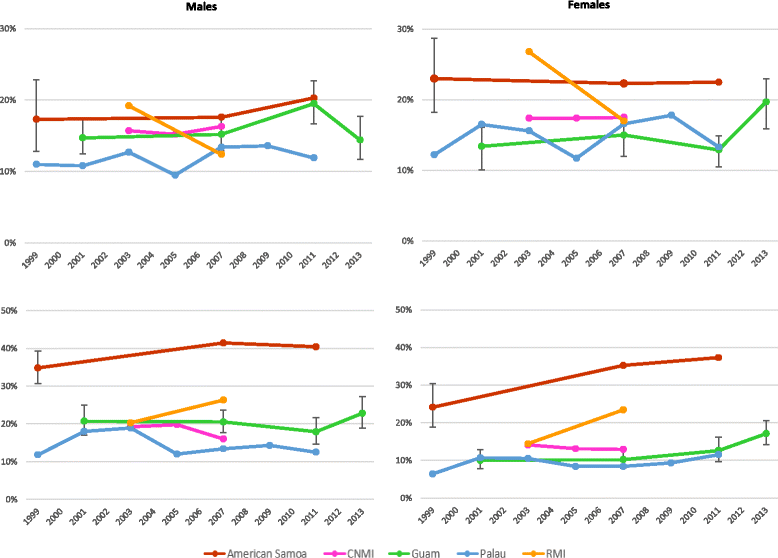Overweight, obesity, physical activity and sugar-sweetened beverage consumption in adolescents of Pacific islands: results from the Global School-Based Student Health Survey and the Youth Risk Behavior Surveillance System
- PMID: 26401344
- PMCID: PMC4572651
- DOI: 10.1186/s40608-015-0062-4
Overweight, obesity, physical activity and sugar-sweetened beverage consumption in adolescents of Pacific islands: results from the Global School-Based Student Health Survey and the Youth Risk Behavior Surveillance System
Abstract
Background: Overweight, obesity and their consequences are challenges to sustainable social and economic development in Pacific island countries and territories (PICTs). Complementing previous analyses for adults, the purpose of this paper is to synthesise available data on overweight, obesity and their risk factors in adolescents in the region. The resulting Pacific perspective for the younger generation will inform both the national and regional public health response to the crisis of noncommunicable diseases.
Methods: We examined the prevalence of overweight, obesity, physical activity and carbonated sugar-sweetened beverage (SSB) consumption, by using published results of two cross-sectional surveys: the Global School-Based Student Health Survey (GSHS) and the Youth Risk Behavior Surveillance System (YRBSS). GSHS was conducted in ten PICTs between 2010 and 2013 and provided results for 13-15 year olds. YRBSS surveys, conducted repeatedly in five PICTs between 1999 and 2013, provided results for grade 9-12 students (approximately 14-18 years) and enabled examination of trends.
Results: Obesity prevalence ranged from 0 % in female students in Vanuatu to 40 % in males in Niue (GSHS). Among grade 9-12 students (YRBSS), obesity was highest in American Samoa (40 % of males; 37 % of females). Approximately 60 % of students in the Cook Islands, Niue and Tonga (GSHS) and American Samoa (YRBSS), were overweight. In both surveys, less than half of students reported engaging in sixty minutes of physical activity on at least 5 days of the past week. Daily consumption of carbonated SSBs in the past month was reported by over 42 % of students in six PICTs (GSHS), and in the past week by more than 18 % of students in three PICTs (YRBSS). In PICTs conducting YRBSS, obesity prevalence remained high or increased within the period 1999-2013.
Conclusion: There is a need for urgent action on overweight, obesity and their risk factors in Pacific youth. The multiple social, economic and physical determinants of this public health crisis must be addressed. This requires all sectors within government and society in PICTs to implement and evaluate policies that will protect and promote the health of their populations across the life course.
Figures

References
-
- Déclaration de Tahiti Nui – Tahiti Nui Declaration (revised November 2011), Noumea, New Caledonia. Secretariat of the Pacific Community. 2012. http://www.spc.int/images/publications/ef/Corporate/ef-tahiti-nui-declar.... Accessed 3 February 2015.
-
- World Health Organization. Yanuca Island Declaration, Yanuca Island, Fiji. World Health Organization. 1995. http://www.pihoa.org/fullsite/newsroom/wp-content/uploads/downloads/2012.... Accessed 3 February 2015.
-
- Pacific Islands Forum Secretariat. Forty-Second Pacific Islands Forum Communique. September 7–8 2011, Auckland, New Zealand. 2011. http://www.forumsec.org/pages.cfm/newsroom/documents-publications/forum-.... Accessed 3 February 2015.
LinkOut - more resources
Full Text Sources
Other Literature Sources
Miscellaneous

